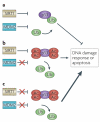How does SIRT1 affect metabolism, senescence and cancer?
- PMID: 19132007
- PMCID: PMC2857763
- DOI: 10.1038/nrc2562
How does SIRT1 affect metabolism, senescence and cancer?
Abstract
SIRT1 is a multifaceted, NAD(+)-dependent protein deacetylase that is involved in a wide variety of cellular processes from cancer to ageing. The function of SIRT1 in cancer is complex: SIRT1 has been shown to have oncogenic properties by downregulating p53 activity, but recent studies indicate that SIRT1 acts as a tumour suppressor in a mutated p53 background, raising intriguing questions regarding its mechanism of action. Here we discuss the current understanding of how SIRT1 functions in light of recent discoveries and propose that the net outcome of the seemingly opposite oncogenic and tumour-suppressive effects of SIRT1 depends on the status of p53.
Figures


Similar articles
-
Role of Sirtuin1-p53 regulatory axis in aging, cancer and cellular reprogramming.Ageing Res Rev. 2018 May;43:64-80. doi: 10.1016/j.arr.2018.02.004. Epub 2018 Feb 21. Ageing Res Rev. 2018. PMID: 29476819 Review.
-
SIRT1 and p53, effect on cancer, senescence and beyond.Biochim Biophys Acta. 2010 Aug;1804(8):1684-9. doi: 10.1016/j.bbapap.2010.05.002. Epub 2010 May 13. Biochim Biophys Acta. 2010. PMID: 20471503 Free PMC article. Review.
-
Negative regulation of the deacetylase SIRT1 by DBC1.Nature. 2008 Jan 31;451(7178):587-90. doi: 10.1038/nature06515. Nature. 2008. PMID: 18235502 Free PMC article.
-
SIRT1 protein levels in cancer: tuning SIRT1 to the needs of a cancer cell.Cell Cycle. 2008 Oct;7(19):2947-8. doi: 10.4161/cc.7.19.7010. Epub 2008 Oct 1. Cell Cycle. 2008. PMID: 18818524 No abstract available.
-
MiR-34, SIRT1 and p53: the feedback loop.Cell Cycle. 2009 Mar 1;8(5):712-5. doi: 10.4161/cc.8.5.7753. Epub 2009 Mar 2. Cell Cycle. 2009. PMID: 19221490
Cited by
-
Expression of sirtuin 1 and 2 is associated with poor prognosis in non-small cell lung cancer patients.PLoS One. 2015 Apr 27;10(4):e0124670. doi: 10.1371/journal.pone.0124670. eCollection 2015. PLoS One. 2015. PMID: 25915617 Free PMC article.
-
miR-1301-3p Promotes Cell Proliferation and Facilitates Cell Cycle Progression via Targeting SIRT1 in Gastric Cancer.Front Oncol. 2021 Apr 27;11:664242. doi: 10.3389/fonc.2021.664242. eCollection 2021. Front Oncol. 2021. PMID: 33987098 Free PMC article.
-
Substituted oxines inhibit endothelial cell proliferation and angiogenesis.Org Biomol Chem. 2012 Apr 21;10(15):2979-92. doi: 10.1039/c2ob06978d. Epub 2012 Mar 6. Org Biomol Chem. 2012. PMID: 22391578 Free PMC article.
-
Sirtuin1 Expression and Correlation with Histopathological Features in Retinoblastoma.Ocul Oncol Pathol. 2015 Dec;2(2):86-90. doi: 10.1159/000439594. Epub 2015 Sep 24. Ocul Oncol Pathol. 2015. PMID: 27172132 Free PMC article.
-
The Immortal Senescence.Methods Mol Biol. 2017;1534:1-15. doi: 10.1007/978-1-4939-6670-7_1. Methods Mol Biol. 2017. PMID: 27812863 Free PMC article. Review.
References
-
- Bordone L, Guarente L. Calorie restriction, SIRT1 and metabolism: understanding longevity. Nature Rev. Mol. Cell Biol. 2005;6:298–305. - PubMed
-
- Campisi J. Suppressing cancer: the importance of being senescent. Science. 2005;309:886–887. - PubMed
-
- Wang C, et al. Interactions between E2F1 and SirT1 regulate apoptotic response to DNA damage. Nature Cell Biol. 2006;8:1025–1031. - PubMed
-
- Nahle Z, et al. Direct coupling of the cell cycle and cell death machinery by E2F. Nature Cell Biol. 2002;4:859–864. - PubMed
-
- Ford J, Jiang M, Milner J. Cancer-specific functions of SIRT1 enable human epithelial cancer cell growth and survival. Cancer Res. 2005;65:10457–10463. - PubMed
Publication types
MeSH terms
Substances
Grants and funding
LinkOut - more resources
Full Text Sources
Other Literature Sources
Medical
Research Materials
Miscellaneous

